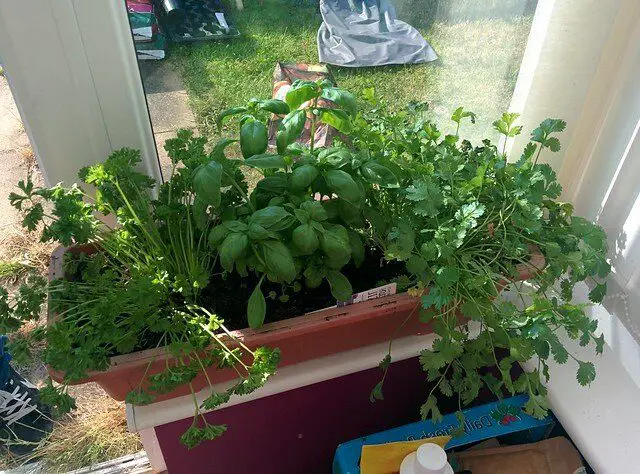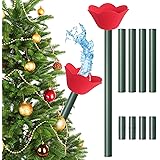Are you eager to start gardening but find yourself living in an apartment without a balcony? Fret not, for there are still plenty of ways to cultivate your green thumb within the confines of your cozy space.
In this article, we will explore the art of gardening in an apartment without a balcony and provide you with creative solutions to bring life and greenery into your home.
So, let’s dive right in and get ready to embark on a fulfilling journey of indoor gardening!
Gardening in an Apartment Without a Balcony
A lack of outdoor space can be a major obstacle for apartment dwellers who want to pursue their passion for gardening. However, just because you don’t have a balcony doesn’t mean you can’t enjoy the benefits of gardening. With a bit of creativity and resourcefulness, you can turn your indoor space into a thriving garden.
In this comprehensive guide, we will explore various techniques, tips, and strategies for gardening in an apartment without a balcony. Whether you have a small studio or a spacious penthouse, there are plenty of options available that will allow you to nurture your green thumb.
Choosing the Right Plants for Indoor Gardening
When gardening in an apartment without a balcony, it’s important to choose plants that thrive in indoor conditions. Here are some options to consider:
1. Herbs
Herbs are one of the most popular choices for indoor gardening due to their compact size and low maintenance requirements. Some common herbs that can be easily grown indoors include basil, mint, parsley, and chives.
They not only add a touch of freshness to your culinary creations but also serve as lovely decorative elements in your apartment.
2. Succulents and Cacti
If you’re looking for plants that require minimal care, succulents and cacti are ideal choices. These hardy plants thrive in dry conditions and can withstand long periods without water.
They come in a wide range of shapes, sizes, and colors, making them a great addition to any indoor garden.
3. Spider Plants
Spider plants are known for their air-purifying properties, which makes them excellent choices for indoor gardening.
They are resilient and can adapt to various lighting conditions, making them perfect for apartments without a balcony. Plus, their cascading leaves add a touch of elegance to any space.
4. Dwarf Varieties
Many plants have dwarf or compact varieties that are suitable for indoor gardening. These smaller versions of popular plants, such as roses, sunflowers, and tomatoes, can be grown in containers or pots inside your apartment.
They require less space and can still produce beautiful blooms or tasty harvests.
Creating a Green Space in Your Apartment
1. Utilize Windowsills
Windowsills offer excellent real estate for your indoor garden. Take advantage of the natural light by placing pots or containers with your chosen plants on the sill. Ensure that the selected plants are suitable for the amount of sunlight available in that particular area.
2. Vertical Gardening
If you have limited floor space, consider incorporating vertical gardening into your apartment. Install shelves, racks, or hanging planters on your walls to maximize the use of available space. This technique allows you to grow a variety of plants without taking up valuable floor area.
3. Create a Hanging Garden
Another way to utilize the vertical space in your apartment is by creating a hanging garden. Hang pots or baskets from the ceiling or install wall-mounted planters. This not only adds a unique aesthetic element to your apartment but also allows you to grow a larger number of plants.
4. Use Room Dividers
Room dividers can serve a dual purpose in your apartment. Not only do they create separate areas in your living space, but they can also provide support for climbing plants. Choose vine-like plants such as pothos or philodendron and train them to grow along the dividers, adding a touch of greenery to your apartment’s interior.
Optimizing Indoor Conditions for Plant Growth
Creating a conducive environment for plant growth is crucial when gardening indoors. Consider the following factors to ensure your plants thrive:
1. Light
Light is essential for plant photosynthesis. Determine the lighting conditions in your apartment and choose plants that are suitable for the available light. If you have limited natural light, you can supplement it with artificial grow lights.
2. Temperature and Humidity
Most indoor plants prefer temperatures between 60-75°F (15-24°C). Avoid placing your plants near drafts or heating vents that can create extreme temperature fluctuations. Additionally, monitor the humidity levels in your apartment and take the necessary steps to increase or decrease it based on the plant’s requirements.
3. Watering
Proper watering is essential for the health of your indoor plants. Avoid overwatering by checking the soil moisture regularly. Each plant has different water requirements, so it’s important to understand the needs of the plants you choose.
4. Soil and Fertilizer
Choose a well-draining potting mix suitable for indoor plants. Regularly fertilize your plants with a balanced fertilizer to provide them with the necessary nutrients for healthy growth.
Dealing with Common Challenges
Indoor gardening comes with its own set of challenges. Here are a few common issues you may encounter and how to address them:
1. Lack of Space
Limited space is a common challenge when gardening in an apartment without a balcony. Use the tips mentioned earlier for vertical gardening and maximizing available space. Consider using hanging planters, wall-mounted shelves, or room dividers to make the most of your apartment’s layout.
2. Pests
Pest infestations can occur even in indoor gardens. Inspect your plants regularly for any signs of pests, such as webs, discoloration, or damage to leaves. If pests are present, treat your plants with organic pest control methods or seek advice from local gardening experts.
3. Lack of Natural Light
If your apartment has limited natural light, consider using artificial grow lights to supplement the lighting needs of your plants. LED grow lights are energy-efficient and provide the necessary spectrum for healthy plant growth. Place the lights at an appropriate distance from your plants to avoid burning the foliage.
4. Noise and Air Pollution
Apartments located in busy areas may have higher levels of noise and air pollution, which can adversely affect your indoor plants. Use air purifiers or open windows when possible to improve air quality. Place your plants away from sources of noise to minimize its impact on their growth.
Gardening in an apartment without a balcony may initially seem challenging, but with the right plants, techniques, and a bit of creativity, you can create a flourishing indoor garden. Whether you opt for herbs, succulents, or compact varieties of your favorite plants, there are numerous options available to transform your apartment into a green oasis.
By utilizing windowsills, vertical gardening, and hanging gardens, you can make the most of limited space. Remember to optimize indoor conditions and address common challenges like pests and lack of natural light. With dedication and care, you can enjoy the beauty and benefits of gardening right in your apartment.
Frequently Asked Questions (FAQs)
Yes, you can have a garden in your apartment even without a balcony. There are various creative solutions and options available for indoor gardening in small spaces.
For apartments without a balcony, you can consider setting up a vertical garden using wall-mounted planters or installing shelves with potted plants. You can also use windowsills, tabletops, or hanging planters to grow herbs, flowers, or small vegetables.
If your apartment lacks direct sunlight, you can place your plants near a window that receives maximum sunlight during the day. Alternatively, you can use artificial grow lights to provide the necessary light intensity and duration for your indoor plants.
Several plants thrive indoors without direct sunlight, such as snake plants, pothos, spider plants, peace lilies, and ZZ plants. Additionally, herbs like mint, basil, and parsley can be grown in small containers.
The watering frequency will depend on the type of plant and the conditions in your apartment. Generally, it is recommended to check the soil moisture regularly and water your plants whenever the top inch of the soil feels dry.
Using a well-draining potting mix is essential for indoor gardening, regardless of whether you have a balcony or not. Look for potting soil specifically formulated for indoor plants. Adding perlite or vermiculite can also improve the soil’s drainage.
Yes, you can grow certain vegetables indoors without a balcony. Leafy greens like lettuce, spinach, and kale, as well as compact varieties of tomatoes, peppers, and herbs, can be successfully grown in containers or vertical gardens in well-lit indoor areas.
To maintain your indoor plants, make sure to dust the leaves regularly, monitor the humidity levels, and avoid overwatering. Additionally, rotate the plants occasionally to ensure even growth and consider using organic fertilizers to provide essential nutrients.
Final Thoughts
Gardening in an apartment without a balcony can be a rewarding and enjoyable experience. Despite limited space, there are plenty of creative ways to cultivate a thriving garden indoors. Using vertical planters and hanging baskets, you can maximize the available space and grow a variety of herbs, flowers, and even small fruiting plants.
Additionally, using self-watering containers and incorporating natural light sources, such as windows or grow lights, ensures that your plants receive adequate nourishment. With dedication and a little research, anyone can successfully create and maintain a flourishing garden in their apartment, even without a balcony.
Auto Amazon Links: No products found.
Perfect Plants Christmas Tree Saver 8oz. | Easy Use Xmas Tree Preserver Food | Have Healthy Green Christmas Trees All Holiday Season
$9.97 (as of December 12, 2025 05:04 GMT +00:00 - More info- Product prices and availability are accurate as of the date/time indicated and are subject to change. Any price and availability information displayed on [relevant Amazon Site(s), as applicable] at the time of purchase will apply to the purchase of this product.
Rocky Mountain Goods Christmas Tree Food - 8 oz Tree Preservative - Reduce Needle Drop - Greener Scent - Fir, Pine, Spruce Trees - Extend Tree Life
$9.95 (as of December 12, 2025 05:04 GMT +00:00 - More info- Product prices and availability are accurate as of the date/time indicated and are subject to change. Any price and availability information displayed on [relevant Amazon Site(s), as applicable] at the time of purchase will apply to the purchase of this product.
VICAMB 39.3 Inch Christmas Tree Watering Funnel,Christmas Tree Watering System Device,Long Tree Watering Funnel Spout for Indoor Outdoor Xmas Tree
$16.99 (as of December 12, 2025 05:04 GMT +00:00 - More info- Product prices and availability are accurate as of the date/time indicated and are subject to change. Any price and availability information displayed on [relevant Amazon Site(s), as applicable] at the time of purchase will apply to the purchase of this product.
FirEver Pure Christmas Tree Food | Preserver Additive & Season Extender for Live Xmas Trees | Keep It Green, Reduce Needle-Drop | Miracle Freshness (8 oz)
$14.99 (as of December 12, 2025 05:04 GMT +00:00 - More info- Product prices and availability are accurate as of the date/time indicated and are subject to change. Any price and availability information displayed on [relevant Amazon Site(s), as applicable] at the time of purchase will apply to the purchase of this product.
EZMeetU Christmas Tree Watering Funnel, 47 Inch Flower Shape Adjustable 6 Section Design, Christmas Tree Watering System, Christmas Tree Waterer, Long Funnel Wide Opening Reusable, Plant Watering Tool
$16.99 (as of December 12, 2025 05:04 GMT +00:00 - More info- Product prices and availability are accurate as of the date/time indicated and are subject to change. Any price and availability information displayed on [relevant Amazon Site(s), as applicable] at the time of purchase will apply to the purchase of this product.
Snow Joe Premium Enviro Blend Ice Melt, Green-Coated Deicer Crystals, 50 lb - Safer Melter for Vegetation, Concrete & Metals w/ Anti-Corrosion Calcium Magnesium Acetate
$32.97 (as of December 12, 2025 19:27 GMT +00:00 - More info- Product prices and availability are accurate as of the date/time indicated and are subject to change. Any price and availability information displayed on [relevant Amazon Site(s), as applicable] at the time of purchase will apply to the purchase of this product.
Muddy Mat® Shown on TV Super Absorbent Microfiber Dog Door Mat for Muddy Paws, Non-Slip Washable Pet Rug, Quick Dry Chenille Entryway Carpet, Machine Washable Indoor Outdoor mat, Grey 30"x19"
$24.95 (as of December 12, 2025 19:27 GMT +00:00 - More info- Product prices and availability are accurate as of the date/time indicated and are subject to change. Any price and availability information displayed on [relevant Amazon Site(s), as applicable] at the time of purchase will apply to the purchase of this product.
ivtivfu Rolling Grill Basket, Removable Wooden Handle, 304 Stainless Steel, Nesting BBQ Tools, Smoker Grilling Accessories for Vegetable, Outdoor Cooking Camping, Birthday Gifts for Men Dad Husband
$25.99 (as of December 12, 2025 19:27 GMT +00:00 - More info- Product prices and availability are accurate as of the date/time indicated and are subject to change. Any price and availability information displayed on [relevant Amazon Site(s), as applicable] at the time of purchase will apply to the purchase of this product.
XXXFLOWER Plant Terrarium with Wooden Stand, Air Planter Bulb Glass Vase Metal Swivel Holder Retro Tabletop for Hydroponics Home Garden Office Decoration - 3 Bulb Vase
$18.98 (as of December 12, 2025 19:27 GMT +00:00 - More info- Product prices and availability are accurate as of the date/time indicated and are subject to change. Any price and availability information displayed on [relevant Amazon Site(s), as applicable] at the time of purchase will apply to the purchase of this product.
Zevo Flying Insect Trap Official Refill Cartridges - Fits Both Zevo Trap & MAX Indoor Fly Trap - Authentic Trap+Lock Technology to Catch Gnats, House & Fruit Flys (4 Official Refill Cartridges)
$14.97 (as of December 12, 2025 19:27 GMT +00:00 - More info- Product prices and availability are accurate as of the date/time indicated and are subject to change. Any price and availability information displayed on [relevant Amazon Site(s), as applicable] at the time of purchase will apply to the purchase of this product.











